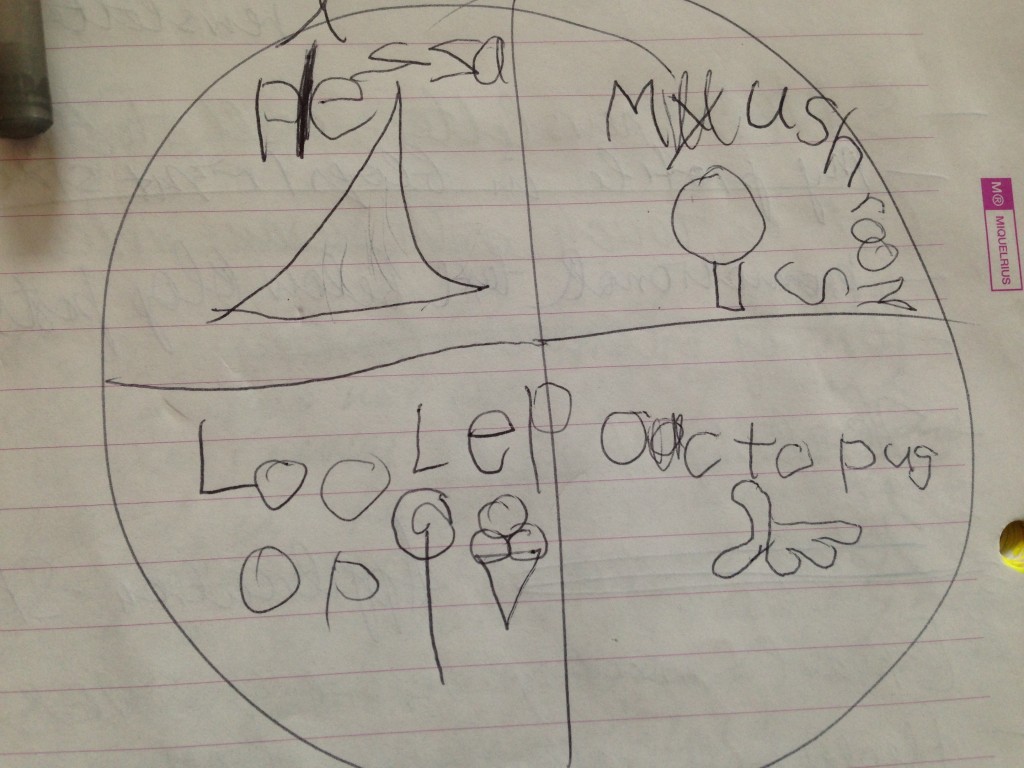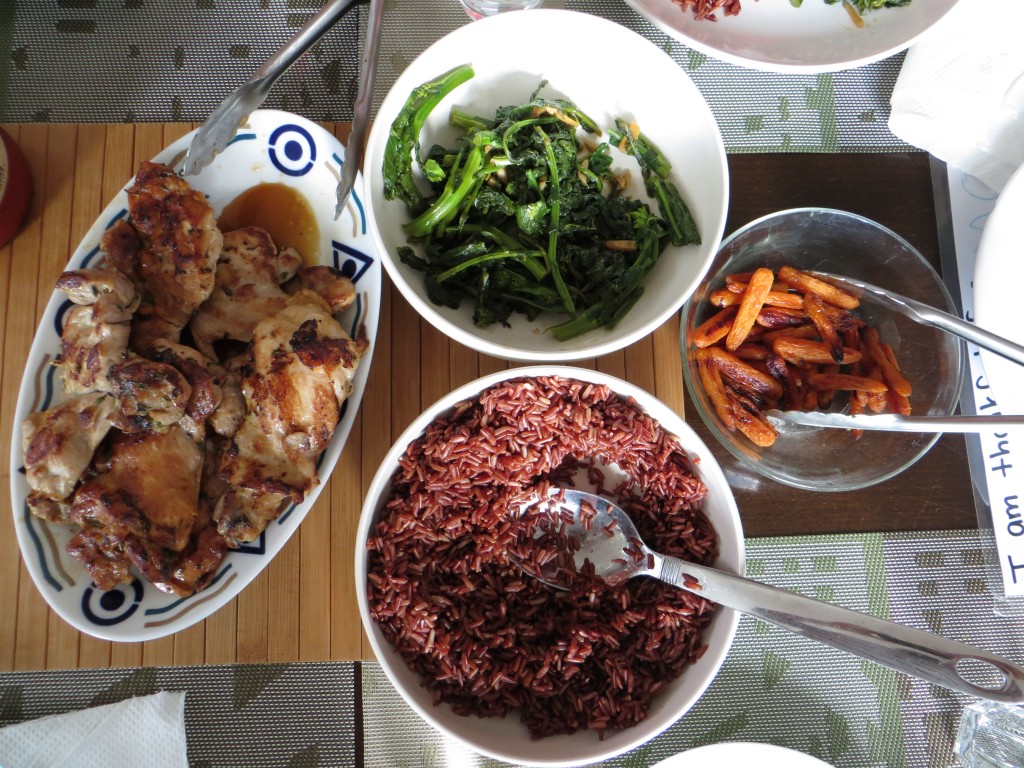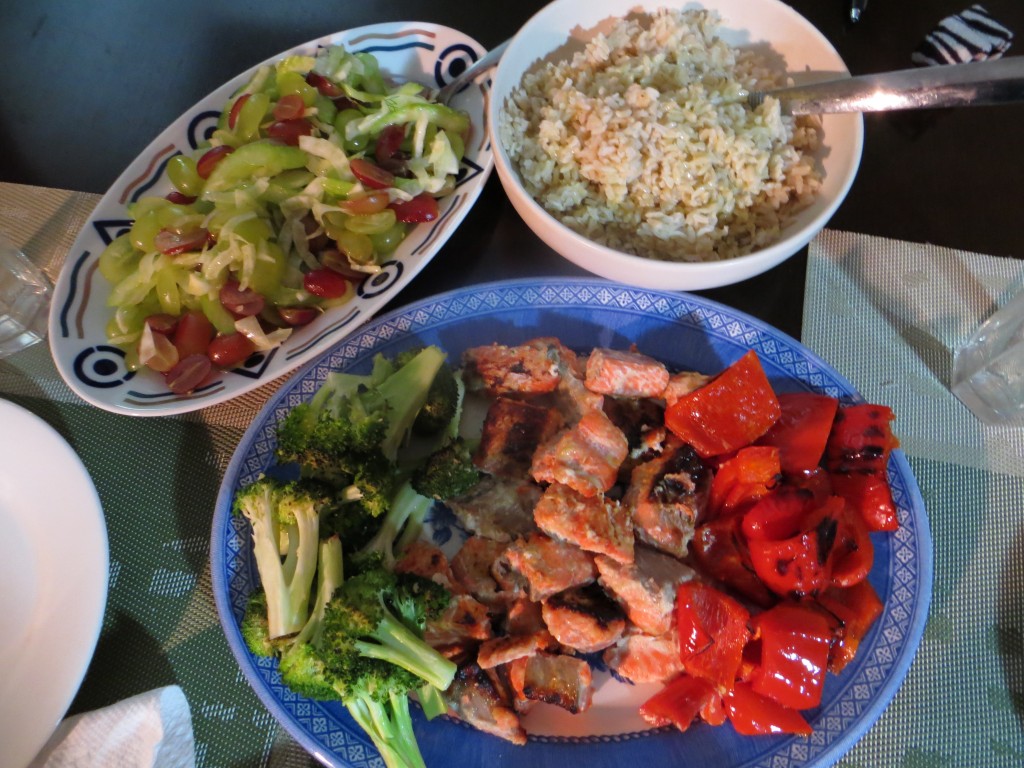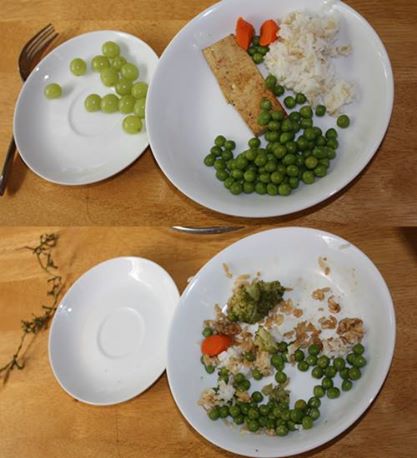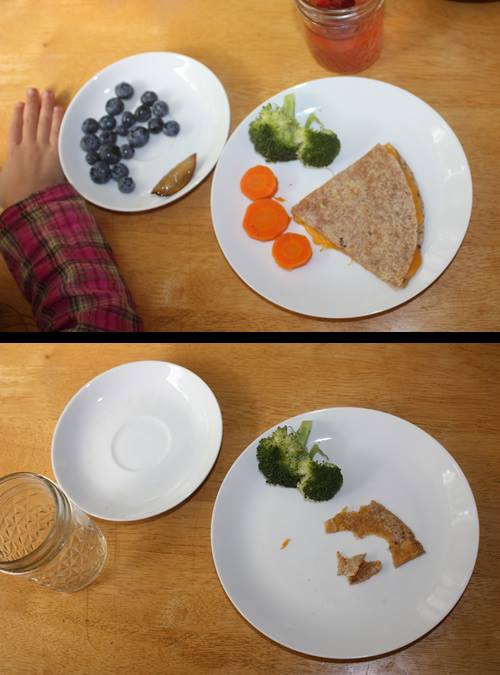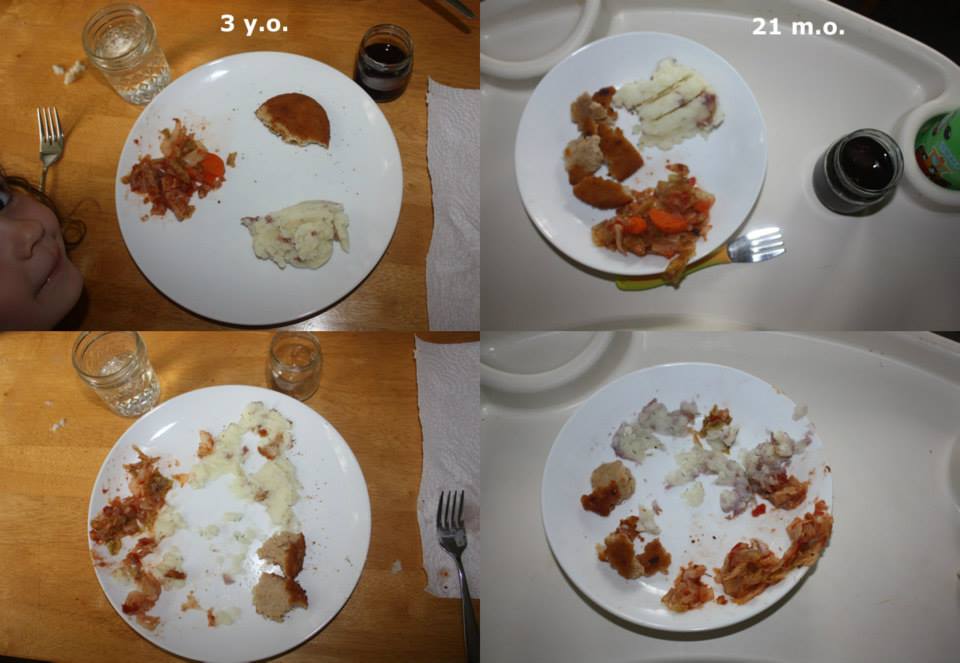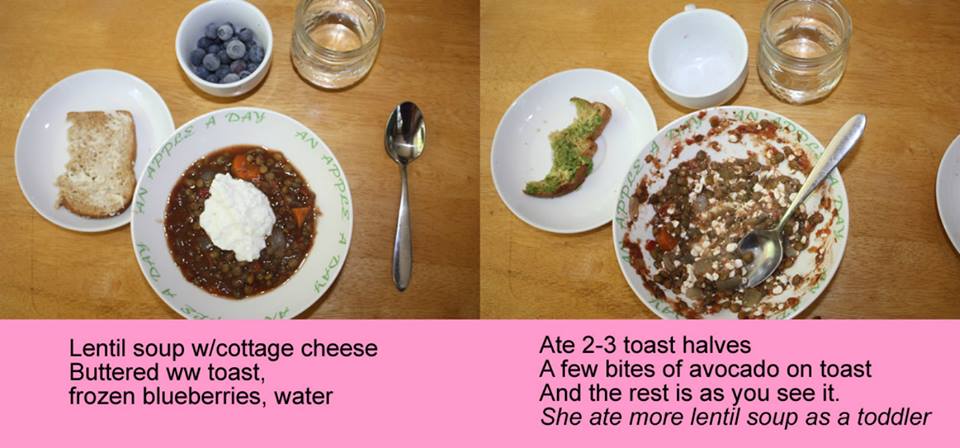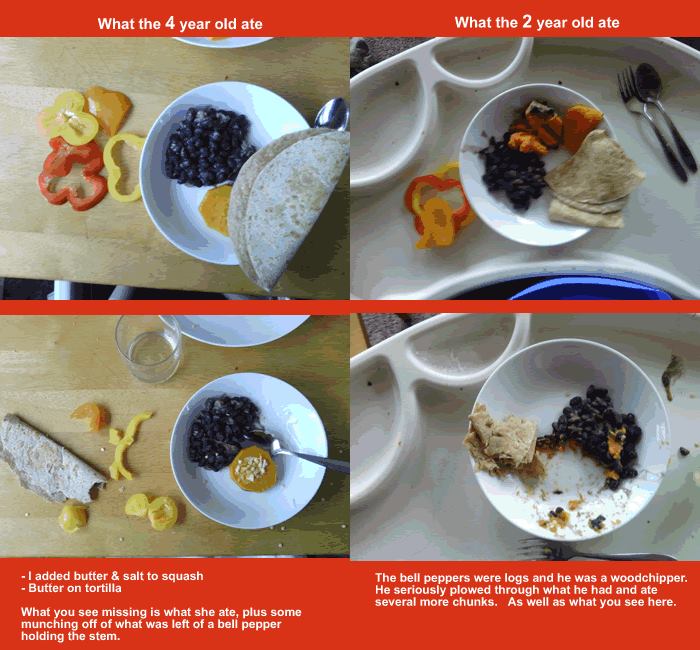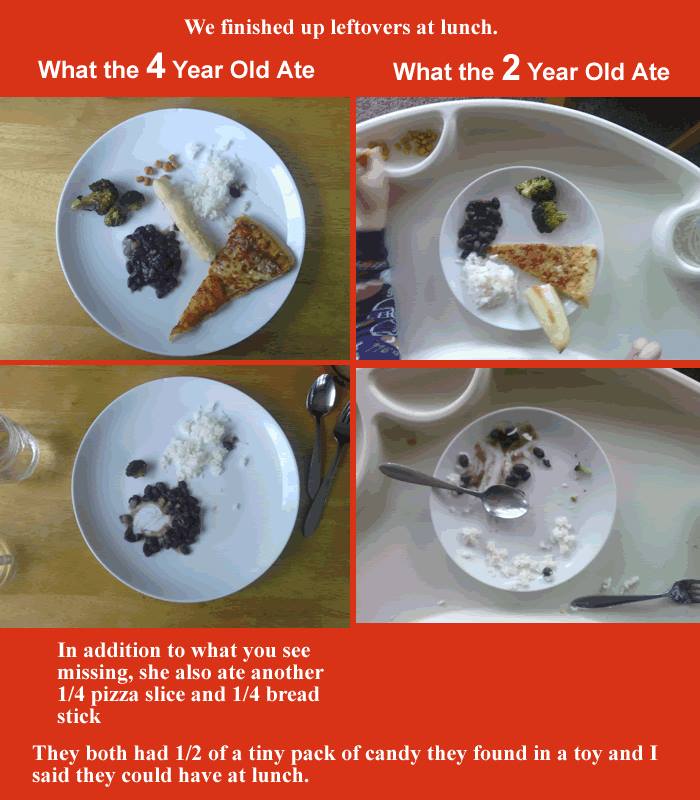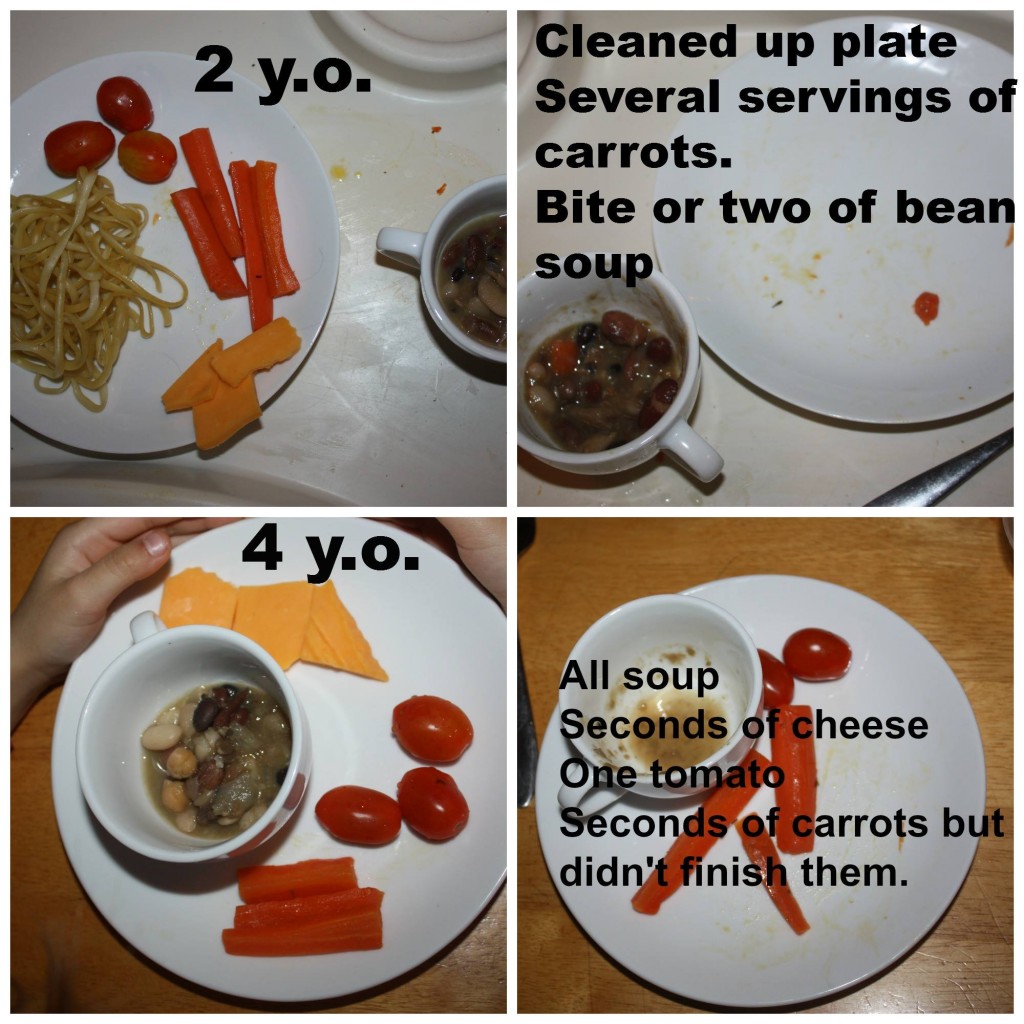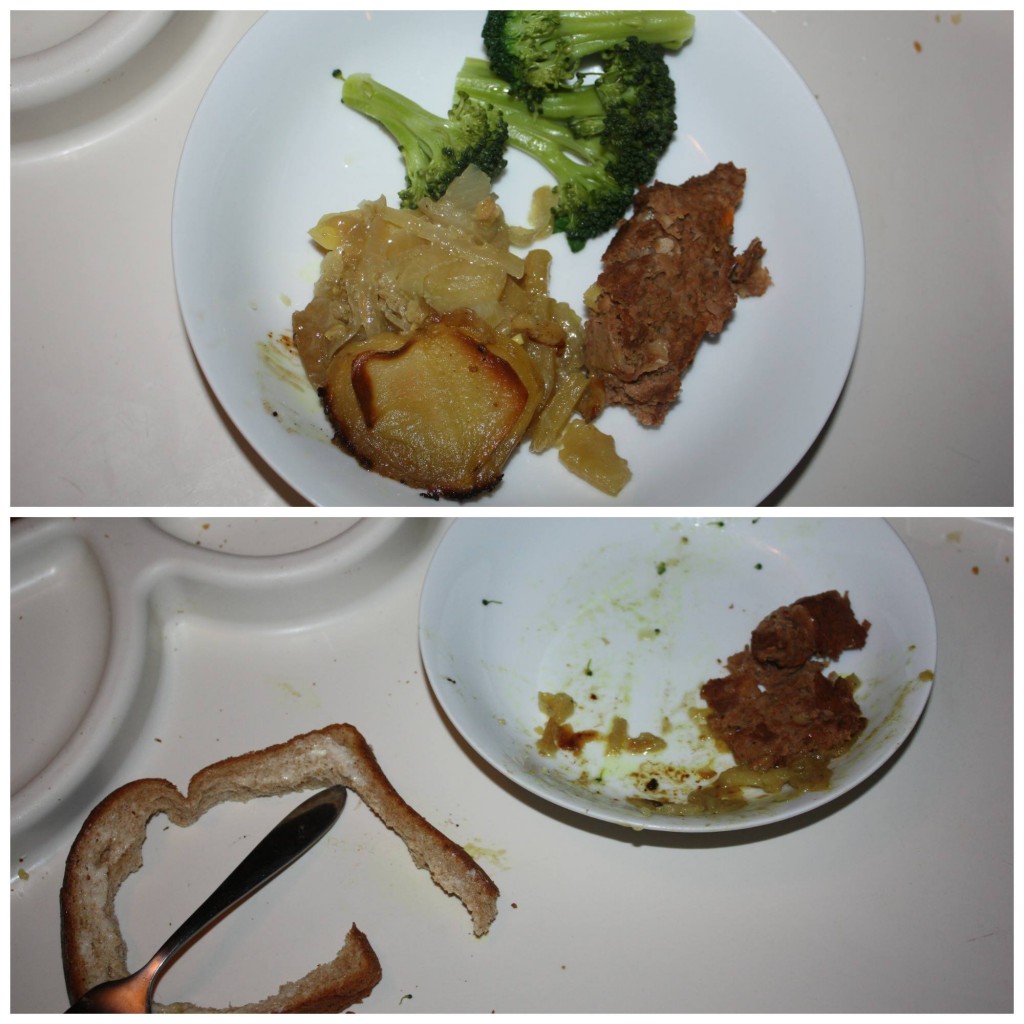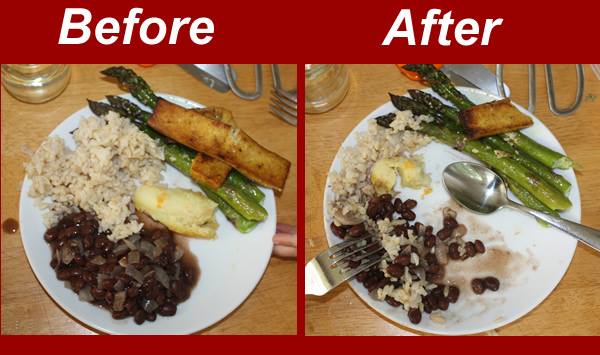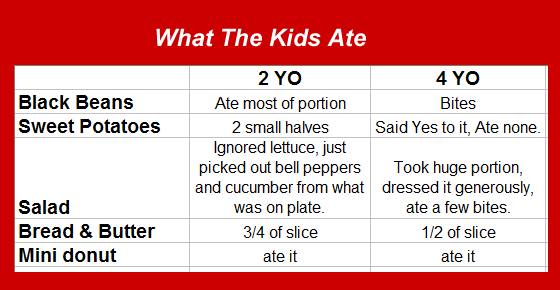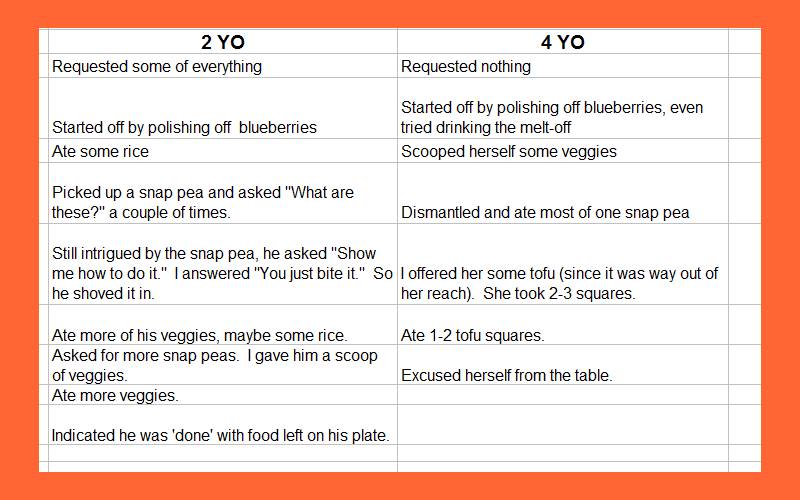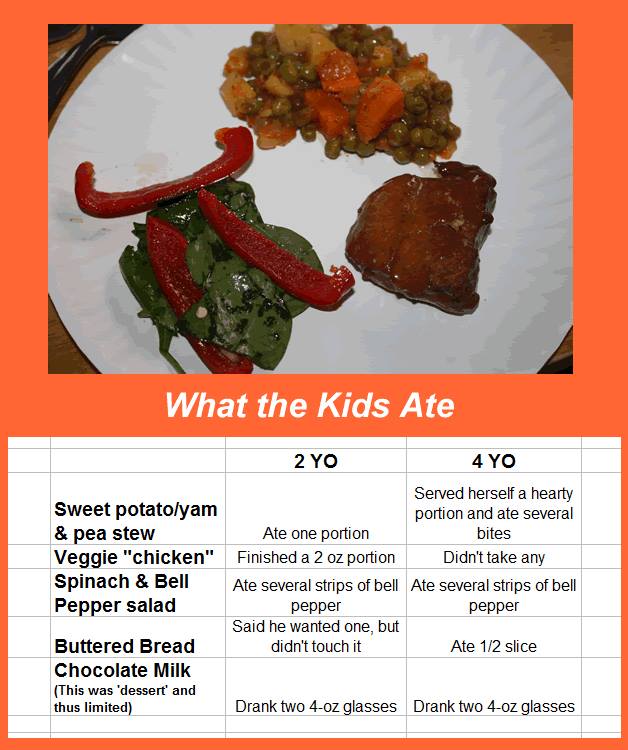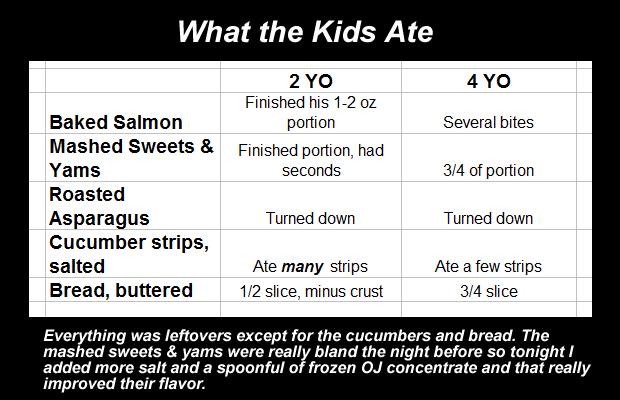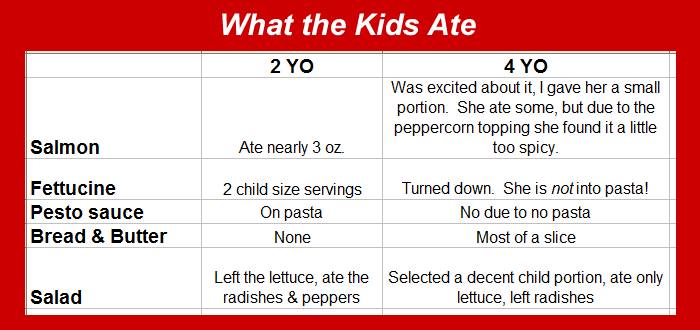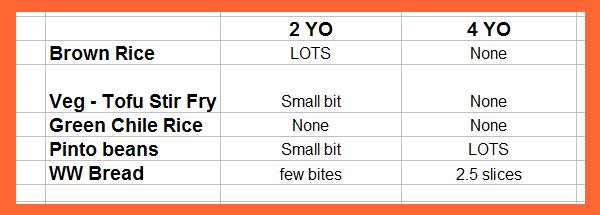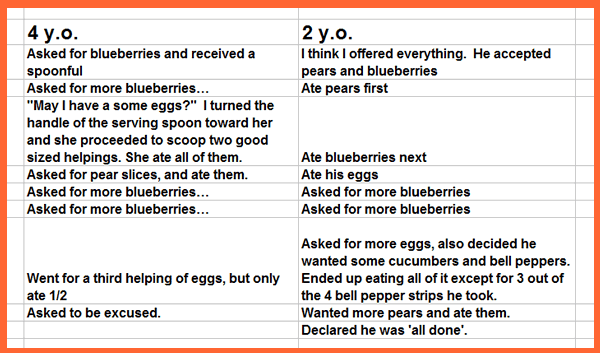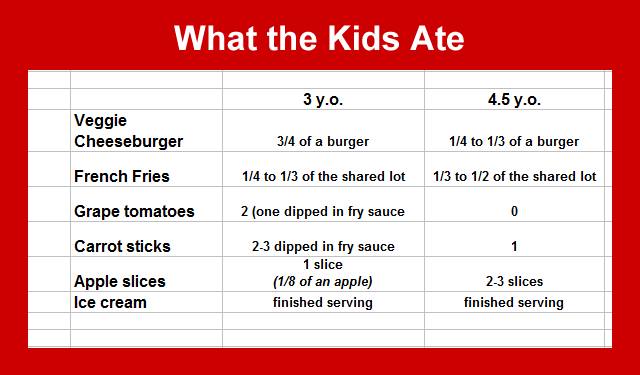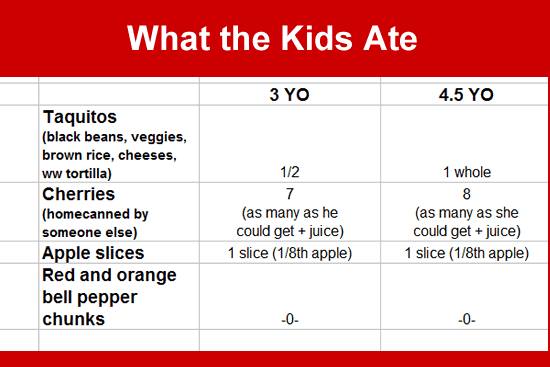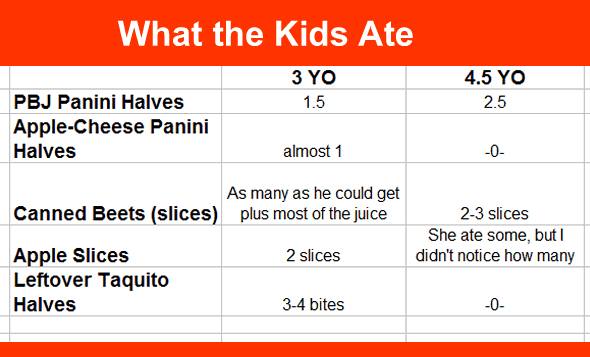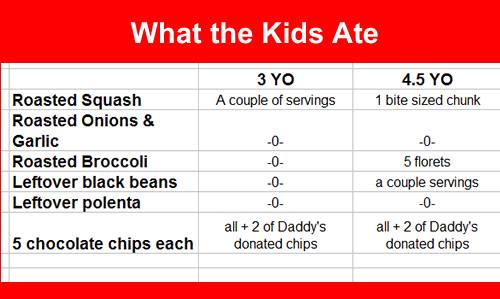In this session we are finally getting to the topic of nutrition. We felt it made the most sense to first talk to you about feeding strategies in the early sessions. Here is why: a positive feeding relationship between you and your child is more important than the most nutritious meals. Just because in the long term, your child’s relationship with food will determine his or her food choices. And we as parents are responsible for helping them have positive experiences with food and eating from the first days of life so that later on they have the tools to make good choices and enjoy eating. The ultimate goal of good feeding is to raise competent eaters, defined here as healthy children who are a joy to feed. Such children:
* Feel good about eating, enjoying food and joining in with family meals and snacks.
* Enjoy meals and behave nicely at mealtime and uses manners.
* Are able to pick and choose from food you make available, eventually learning to eat almost everything you do.
* Eat as much or as little as they need.
“When the joy goes out of eating, nutrition suffers” – Ellyn Satter
Of course we believe that nutrition is important. We became Registered Dietitians for a reason :). But we also know that if we make nutrition a chore, it is not going to benefit anyone.
And although counting grams may become necessary if your child is deficient in certain nutrients or you are switching to another diet like vegan or dairy free, we prefer to focus on food group balance and variety.
Adina, as a semi-vegetarian, knows it is easy to rely heavily on cheese, so she makes an effort to make sure she varies protein sources.
Natalia rarely serves fried food but she always serves an additional source of fat like olive oil, butter or sour cream on the table so every family member could add as much as they see fit.
Let the following nutrition details guide you insofar as ideas hit you, ideas about where you might need to tweak this or that a bit. If any of these nutrients concern you then evaluating what you serve may help you make needed improvements. For example, if you realize that you aren’t serving much in terms of high fiber foods or there’s constipation or iron deficiency amongst your children, then focusing on those areas and what is served would be helpful. Otherwise, think of the big picture: balance and variety.
That is why, in this session, instead of strict rules you will find suggestions on nutritious foods you can serve to your child to help her meet nutrient needs, information on planning balanced and nutritious meals that are also satisfying and suggestions on how to choose supplements for your toddler.
Basics of a balanced diet for toddlers
Here is a picture by Natalia’s 5 year old that represents her ideal meal. Translation: pizza, mushrooms, octopus and lollipop. Pretty balanced, don’t you think?
But jokes aside, kids need to be served a balanced diet in order to learn to eat a balanced diet. Even if all they choose to eat is just one food.
Here are the food groups and amounts an average toddler needs to be served daily:
– 2-4 oz meat or beans
– 1-1.5 cup vegetables
– 1-1.5 cup of fruit
– 3-5 oz of grains
– 2-3 servings of dairy (including all milk products and formula)
Does it mean that you should pressure your child to eat these exact amounts? Not really – your job stays the same – serve the food and allow your child decide how much to eat. Will your child eat a balanced diet if you let him pick and choose from what you serve? Most likely, yes. If you are in doubt, try recording everything he eats over a few days, or even better, a week. Most toddlers will manage to eat in a very sensible way if we look at a longer period of time, not just 1 day.
Here is a sample meal plan with ‘starter’ portions: Sample_Meal_Plan — 1_to_3. Remember your child may need more or less at any given meal, let his appetite lead him.
As far as serving sizes are concerned, you toddler will need only about a tablespoon of food from each food group at a meal. But it does not mean that he will not want more of something and will not touch other foods. See the Before and After Meal Photos and What the Kids Ate (in the subsections below) of what Adina’s kids eat – it is a pretty typical toddler eating behavior. They eat a lot of something one day, do not touch it another day, pile lots of things on the plate and do not touch them, eat their mini dessert first etc. While it is frustrating, it is hard to expect them to eat 3 square balanced meals a day plus snacks. Meal skipping and one-ingredient meals are pretty common at this age.
What is a balanced meal?
To **serve** a balanced meal, you will need 3-5 foods from at least 3 food groups. Include some kind of protein, one or two starches, a vegetable, fruit or milk.
Kids learn best by serving food on their own plates. Of course your 18 months old may need your help or even pre-plating but kids 2 and older enjoy being more independent at mealtimes. You do not need elaborate dinnerware to serve a meal family style. To make her job easier, Adina may serve food family style in pots and pans. Natalia often does this too or she transfer the food into small serving bowls after cooking and uses them as storage containers by covering the leftovers with foil or plates before putting away in refrigerator.
Include **high fat and low fat food** in each meal. Kids need lots of energy and fat is a great source. By adding a good source of fat on the table you will allow kids easily adjust the amount of calories they need on a particular day. Besides, fat makes food taste good! So make sure to combine foods with different fat content or simply put a fat like butter or olive oil on the table. For more on fats, see the section below.
When choosing **starches**, serve whole grain about 50% of the time. While fiber is very beneficial for both kids and adults, as you will see in the following sections, it is easy to go overboard if your child eats lots of whole grains plus fruits and vegetables. Too much fiber may interfere with nutrient absorption and make kids feel full without eating a sufficient number of calories.
Do not worry if your child skips **vegetables**. Vegetables are harder for kids to learn to like. By seasoning them well and using different cooking methods you will help your child find his favorites sooner.
Your can also try serving vegetables to your child when he is at his hungriest – right before a meal. Natalia puts a tray of veggies with a simple dip for the kids and her husband to nibble on while she is finishing preparing dinner.
Review our Session 10: “Increasing Variety” for more ideas on how to serve new foods, including vegetables, to your child.
But above all, do not stress if your toddler consistently refuses veggies. If he likes fruit, serve them more often and enjoy vegetables yourself often, while putting no pressure on your child and you will see positive results sooner!
We have many parents coming to our practices because they are concerned that their child is not getting enough **protein**. But as we proceed through the counseling session, it often becomes obvious that while the child’s diet may not be optimal, protein is often not an issue.
Just 2 cups of milk or other servings of dairy provide most of protein needs for an average 2 year old which are only 19 grams per day. So if your child drinks a cup of milk in the morning and eats some cheese at lunch he will meet his protein needs without any problems even if he ignores the chicken you serve for dinner. In fact, most of us in the US eat 2 to 3 times more protein than we need.
When brainstorming protein option for a meal, do not forget that beans and lentils also pack a good amount of protein. Beans and lentils are very nutritious and easy to like for little kids because of their mild flavor. Need ideas on how to prepare them? Check this lentil and white bean soup recipes from Natalia’s blog.
And it is not a big deal if you don’t include protein rich foods in every meal. Even common carbohydrate rich foods like grains provide 2 to 4 grams of protein per serving. So you do not have to worry if your child does not eat meat, fish or beans at each meal.
Important foods and nutrients
Some of the food and nutrients are more important than others for toddlers because of toddler’s unique needs and also because they are more likely to fall short on them. Read more about the most important nutrients here: Important nutrients_1to3yrs — It may be a useful resource for you if your feel like you need to serve more of food providing certain nutrient/s. Below we will address common nutrients in more detail.
Dairy basics – too much or too little
Milk and other dairy products provide a great source of calcium, vitamin D, protein, magnesium and other important nutrients in your child’s diet. Many toddlers love their dairy and have no problem eating and drinking the required amount. But some toddlers eat too much dairy while others refuse it completely.
General guidelines:
Children under 1 year of age should not be served cow’s milk. Breast milk or iron-fortified formula are more appropriate for them.
Children from 1 to 2 years of age can be breastfed or served full fat cow’s milk or formula.
Children older than 2 can be transitioned to 2% or skim milk if this is what your family drinks.
Toddlers need around 700mg of calcium per day.This goal is easily reached by serving dairy twice a day. In our Western diet, dairy is the main source of calcium, with each serving providing between 250 and 400mg of this important nutrient. However, there are many non-dairy foods providing a good amount of calcium, such as:
- fortified ready-to-eat breakfast cereals, 1oz – between 300 and 1000mg
- leafy greens, 1/2 cup cooked – around 150mg
- beans and peas, 1/2 cup, cooked – around 100mg
- canned sardines with bones, 3oz – 325mg
- fortified tofu, 1/2 cup – 253mg
- fortified orange juice – around 350mg
- fortified soy milk and other milk substitutes – around 350mg.
- For other non-dairy sources of calcium, check this article.
Recommended daily amount of ALL dairy products for children 2-8 years old – only 2-3 servings a day.
1 serving of dairy foods = 8 oz milk, 8 oz yogurt, 2 oz cheese, ½ cup ice cream.
It is easy for toddlers to drink too much milk. Too much dairy can displace other important foods from the diet and even lead to iron deficiency if consumed in excess.
If your child eats too much dairy. Children who eat too much dairy tend to eat less of other foods and be finicky about their food choices. They may fill up on milk between meals, request yogurt for snack and refuse meat of veggies at dinner time. If this is your case, try to gradually “wean” your child off snacking on dairy foods all the time. Milk is not a snack, it is very filling and may prevent your child from eating good meals.
If your child refuses milk but eats other dairy foods. If your child eats foods like yogurt, cheese and ice cream, she should be getting all the required nutrients from them.
If your child does not eat dairy. If your child is not allergic to dairy foods, try fortifying meals with evaporated milk or powdered milk. They can be added to recipes for baked goods, pureed soups or desserts. If your child is vegan or is allergic to dairy, include other calcium and vitamin D-rich foods such as fortified soy milk or orange juice and include more of the non-dairy sources of calcium listed above. If your child is lactose-intolerant she may be able to tolerate lactose-free milk and fermented dairy products such as aged cheeses and yogurt.
How much fiber does your child need?
Many of the toddlers we see in our practices do not get enough fiber. It is hardly surprising if we take into account their small appetites and erratic eating habits. There are some simple ways to add a little more of this important nutrient in their diets! Fiber prevents constipation, aids digestion and supports health of the digestive system. Oh, and they also help them stay full longer, so you are less likely to hear “I am hungry” 30 minutes before dinner!
Toddlers need about 19 grams of fiber per day.
Here are some of the good sources of fiber:
- Oatmeal (½ cup cooked, 2 grams)
- Berries (½ cup, 4 grams)
- Whole grain cookies or crackers (at least 3 grams per serving)
- Sweet potatoes with peel (½ of medium, 3.8 grams)
- Sliced apple (1 small, 3.6 grams)
- Almonds/Almond Butter (1 tablespoon, 1 gram)
- Whole Grain Bread (1 slice, 4.4 grams)
- Legumes (½ cup cooked, 6.2-9.6 grams)
One of Natalia’s kids was constipated as a toddler because of drinking too much milk and not eating a lot of fiber rich foods. Having learnt her lesson, she is now more mindful about fiber and its good sources. Here are some of the ways Natalia adds fiber to her kids’ diet:
- Including vegetables and/or fruit in every meal and snack.
- Enjoying whole wheat pasta with olive oil, milk and fruit for breakfast, her kids’ favorite.
- Making smoothies for dessert or breakfast with frozen berries and yogurt or kefir.
- Using 100% whole wheat flour for baking muffins and pancakes. For pastries and cakes, she uses 100% whole wheat pastry flour which has less gluten and yields more tender products.
- Her family does not eat a lot of breakfast cereal but if she happens to buy one, she makes sure it has at least 3 grams of fiber per serving.
- She makes this lentil soup (http://tribecanutrition.com/2013/03/lentil-soup/), Moroccan chicken and chickpea stew (http://tribecanutrition.com/2013/02/moroccan-chicken-with-chickpeas-and-vegetables/) and white bean soup (http://tribecanutrition.com/2012/11/white-bean-and-sausage-soup/) that are chock full of fiber from vegetables and pulses.
- She bakes potato wedges with skin, to preserve the fiber which otherwise gets discarded. To bake a nice batch of crispy potato wedges, scrub potatoes well under running water, cut into wedges about 1 inch thick at the bottom, season with salt, pepper and olive oil and bake in a preheated to 350F oven for about 35-40 minutes. Serve with tomato sauce or your favorite dip.
- She uses unpeeled potatoes and fiber-rich kale in this easy one-pot recipe (http://tribecanutrition.com/2013/01/kale-potato-and-bacon-dinner/).
- She adds a few tablespoons of wheat or oat bran to muffin and pancake mixture.
- She adds pureed vegetables like carrots, spinach and canned beans to meat sauce (http://tribecanutrition.com/2013/07/15-minute-vegetable-meat-sauce/) she serves with pasta and lasagna.
- She mixes in vegetables like mushrooms into meatballs (http://tribecanutrition.com/2012/05/turkey-mushroom-meatballs/) and meat loaves.
- She uses whole wheat tortillas to make quesadillas (http://tribecanutrition.com/2013/04/chicken-spinach-quesadillas/).
- She makes whole wheat pita chips (http://tribecanutrition.com/2014/01/pita-chips-and-hummus/) to go with homemade hummus.
- She often starts a family meal with a pureed vegetable soup (http://tribecanutrition.com/2013/05/pureed-vegetable-soups/).
- She makes no-cook fiber-rich chia seed pudding (http://tribecanutrition.com/2013/04/chia-seeds/) for breakfast, snack or dessert.
- She packs whole grain salads (http://tribecanutrition.com/2013/04/lunch-special-secret-grain-salads/) in kids’ lunch boxes.
- She makes pizza (http://tribecanutrition.com/2012/06/mushroom-pizza/) at home with whole wheat dough and mushrooms as a topping.
- She serves fresh fruit instead of fruit juice. An unpeeled apple has about 3.6 grams of fiber but a cup of apple juice (with sugar equivalent of 3 apples) has none!
- She serves popcorn for snack. Here is how we make ours on the stove (http://tribecanutrition.com/2012/07/popcorn-on-the-stove/).
What to do it your picky toddler is constipated and needs to get the things moving before he is ready for adding all these fiber rich options to his diet?
Of course, now that you’re an expert in what your feeding jobs are, you know that pressuring kids to eat these foods is out of the question. Besides, if your child has been constipated for a while, just adding fiber from grains, fruit an vegetables is not going to make a dramatic difference quickly. But your child may need help fast. Not only constipation is terribly uncomfortable, it also may lower your child’s appetite – not a good thing for someone who needs to grow and develop!
That is why, if this is your case, we would recommend speaking to your doctor about an appropriate laxative to help relieve the existing constipation while working to improve his eating by keeping to your feeding job description.
Safe laxative could be a quick solution that will give you time and a level of comfort to continue working on improving your child’s diet through non-pressure mealtimes, structure in meals and snacks and providing balanced and nutritious meals.
The fat issue – are they getting enough?
Although this has begun changing in the last few years, for a long time health conscious people tended to think that “healthy” was synonymous with “low fat.” However, low fat diets are not appropriate for kids under 2 years of age. Besides, there is no limit on how much saturated fat they can eat, giving them a free pass on butter, whole fat milk and yogurt. In fact, saturated fat is an important constituent of brain cell membranes, so limiting it in small kids is not recommended.
Kids 2 and older may start eating low fat dairy if this is what your family is eating. However if your family prefers whole fat dairy products, you can keep using them. Just keep things in balance and make sure whole milk and butter do not turn every food item/meal into a high fat item/meal.
But how do these recommendations translate in family meal context?
Serve foods with a variety of fat content for each meal. By combining some high fat foods with low fat foods you will give your child the opportunity to pick and choose depending on the amount of energy he needs on that particular day. Remember that kids are wonderful at self-regulating?
Fat is a wonderful flavor and aroma carrier making foods extra tasty. Fat content also tends to make a meal stick a bit longer. Thus using fat to enhance the flavor of otherwise bland vegetables can be helpful in making them more palatable for some children. But not everything on the table has be dripping in oil, smothered with cheese or slathered with butter. In the short chart below, notice the difference between the all high fat meal and the two medium fat meals.
High fat meal Whole milk, buttered broccoli, breaded fried chicken cutlets, heavily buttered potatoes,
Medium fat meal Whole milk, steamed broccoli, baked/roasted chicken, buttery potatoes, grapes
Medium fat meal 1% milk, cheesy broccoli, baked/roasted chicken, lightly buttered potatoes and toast with butter, grapes
Low fat meal 1% milk, steamed broccoli, baked/roasted chicken, light buttered potatoes, grapes
You can see above that by including or preparing some foods with little to no fat, you can keep the fat level in balance without sacrificing flavor. Of course the occasional high fat meal won’t hurt anyone, but in general it is good to aim for a moderate fat intake rather than either a very low or very high extreme.
While we are still waiting on conclusive research on the effects of saturated fat on health, surveys show that kids are not getting enough of known healthful types of fat like plant and fish oils. Some examples of foods rich in these fats include olive oil, avocados, nut butters and wheat germ. The same foods are also rich in Vitamin E, another nutrient of concern in toddlers. An easy way to boost healthful fats is by cooking with olive oil, serving peanut butter sandwiches, avocados and avocado dips and adding wheat germ to home baked muffins and pancakes.
DHA
One of the polyunsaturated fats, called DHA, seems to be particularly beneficial for kids, especially under 2 years of age. DHA is an Omega 3 fatty acid that is crucial for retinal and brain development in the first two years of life.
Two weekly servings of cold water fish is all we need to get enough DHA. But if your child is still learning to like fish, supplementation may be required to help him bridge this gap. We will discuss supplementation in the section below.
Safe ways to boost DHA in your toddler’s diet:
1. Choose better fish. Some types of fish may contain more mercury than others. Mercury is an environmental toxin that can cause learning problems in children so it makes sense to limit fish high in mercury for everyone and especially for pregnant and breast-feeding women and small children. Consult this brochure by the Environmental Protection Agency (EPA) (http://www.nyc.gov/html/doh/downloads/pdf/edp/mercury_brochure.pdf) to chose the fish which is lower in mercury and other environmental contaminants.
2. Start early. According to the current recommendations by American Academy of Asthma, Allergy and Immunology (AAAI) (http://www.jaci-inpractice.org/article/S2213-2198(12)00014-1/fulltext), delaying introduction of potentially allergenic foods like eggs, fish, nuts, peanuts and wheat, after 6 months of age, may increase risk for food allergies later in life and definitely does not help to prevent them. Keep serving fish 2 times a week even if it is rejected initially. Kids need a lot of repeated exposures to learn to like a new food.
3. Get creative. For older children who do not like fish, try different presentation and cooking methods. Some kids will eat fish if it is covered in breadcrumbs, grilled on skewers or made into fishcakes. Here is a recipe for home made fish fingers (http://tribecanutrition.com/2012/06/homemade-fish-fingers/) that take only 15 minutes to prepare, nori-salmon sticks (http://tribecanutrition.com/2012/03/795/) made with wild salmon rich in Omega 3′s and grain and pasta salads with canned tuna (http://tribecanutrition.com/2013/04/lunch-special-secret-grain-salads/) that has a milder flavor than fresh fish.
4. Read the labels. If milk and juice are fortified with DHA, the amount is usually specified on the label. Although it is not likely that your child gets a lot of DHA from these beverages, it may be just the extra step that is needed to meet the recommendations. The labels on fortified eggs, on the other hand, typically specify the total amount of Omega3′s the eggs contain so it is harder to figure out how much DHA and EPA you are getting.
5. Go plants. Explore plant sources of omega-3 fatty acids, such as the oils of flax, canola, hemp and soy, as well as walnuts, chia, hemp, flax seeds (ground), and green leafy vegetables. However, since the plant form of omega-3s (ALA) is not converted into DHA and EPA efficiently, these foods cannot be used as the only source of omega-3′s in diets of small children younger than 2 years of age. As a result, these children may need a supplement if they are not eating fish.
A bonus of serving more DHA rich fish to your toddler is that you will also help him meet his vitamin D needs. But since food sources of vitamin D are so scarce and fish is rarely among kids’ favorites, most kids need a supplementation to meet their needs, especially in the winter months.
For more information of good food sources of DHA an vitamin D check out the Important Nutrients for Toddlers handout in the materials section of the class.
Iron – “these meatballs are too chewy!”
Most toddlers have trouble eating meat because of its challenging texture. Besides, they are likely to overdo in the dairy department making them uniquely susceptible to developing iron deficiency – the most common nutrient deficiency in kids. Not enough iron may affect the developing brain so it is good to have a strategy to include more iron rich foods in your child’s diet.
It is all about the right combination
Iron from animal sources or “heme” iron (meat, poultry, fish) is absorbed easier than iron from plant sources or “non-heme” iron (lentils, spinach, tofu). When non-heme iron is served with heme iron ( spinach +chicken), the iron from spinach is absorbed better than if spinach is served alone. Vitamin C rich foods (most fruit and vegetables) have the same effect on both heme and non-heme iron absorption. So even a couple of bites of meat of chicken at dinner will help your child absorb more iron from plants. And if you are a vegetarian family or your child does not like meat yet, make sure to serve the plant food rich in iron (http://www.vrg.org/nutrition/iron.php) together with vitamin C rich foods.
For more information on good sources of iron, see our printout Important Nutrients for Toddlers in the Materials section of the class.
How to help your child eat more iron rich foods
As with everything else, the Division of Responsibility comes to the rescue! Sticking to mealtime structure, scheduling snacks and offering a variety of nutritious foods at meals and snacks will help your child learn to like iron rich meat and greens sooner.
You may also try making iron rich meat easier to handle for the little ones by making it moist and tender. Beef stew and chicken soup are some of Natalia’s kids’ favorites.
Also, adding fat and seasoning to plant dishes rich in iron like beans and greens will make them much more palatable for kids.
Supplementation
Most toddlers, even the pickier ones, do not need a supplement. What seems like an erratic diet, with a sketchy intake from each food group, may actually still provide all the nutrition your child needs.
But in some cases, like when a child eats no fruit or vegetables at all or takes time to warm up to fish, a supplementation may help to close the potential nutritional gaps.
There are a few things every parents should know before choosing a supplement:
- Supplements are not tested by FDA for safety and efficacy.
- Instead of choosing individual vitamins and minerals, it is better to choose a multivitamin formula with minerals. Supplementing just one nutrient without your doctor’s approval may impair absorption of other nutrients and affect your child’s health.
- Choose the supplement that provides <100% of Daily Value (DV) of vitamins and minerals. Too much may not be a good a thing.
- If your child eats a very restricted diet, choose a more comprehensive supplement with trace elements from a reputable brand instead of cute gummy bears that often have only a handful of nutrients. If you need specific recommendations, leave us a comment in the discussion section or send an email.
- Do not give your child supplementation with iron unless recommended by your doctor.
- You child may need vitamin D supplementation, especially if you live in the Northern hemisphere. Kids under 2 need 400IU and older children need 600IU daily.
- If your child is under 2 and he does not eat fish, he may need a DHA supplement. It is very important to choose a reputable brand when buying DHA supplements. One of the best we can recommend is Nordic Naturals.
- Probiotics have been featured in many research articles lately. While we still need to learn more about what types of strands are more beneficial for certain conditions, it is clear that probiotics are very safe. The best ways to obtain beneficial gut bacteria is though eating fermented foods like kefir, yogurt, sauerkraut and kimchi. But if your child does not or cannot eat these foods, adding a probiotic with a variety of strands providing about 1 billion of CFU (colony forming units) will help in the meanwhile.
- Finally, for more information on supplements, you can check FDA’s website http://ods.od.nih.gov (Office of Dietary Supplements). Or choose a subscription service by an independent supplement testing organization like Consumer Labs (http://www.consumerlab.com/) to see quality ratings and comparisons of different supplements.
At a risk of sounding like a broken record, we encourage you to not get too worried about the exact amounts of nutrients you child should be eating. We build this session to give you an estimate of what you should be serving and we are confident that with the Division of Responsibility in place–you sticking to your feeding job so your child can do his eating job–you child will start eating better with time.
If you feel you need more help nutritionally fine-tuning your child’s diet, we encourage you to get in touch with a dietitian who will be able to assess your child’s current eating habits and make suggestions based on this. Although we do our best to cover the most common nutritional issues, your problems may be more specific than what this class can encompass. If you need help finding a dietitian in your area or someone who consults online, please send us an email at feeding bytes@gmail.com.
In our resources section we will add some snack ideas/recipes that might help you get more ideas on the ‘what’ of feeding.
Before & After Meal Photos
Just for fun Adina has kept track of her kids’ eating for the sake of sharing on her FB page to help other parents see variants of normal. Here are a few photos for your perusal. Keep in mind her 4.5 y.o. daughter is the “pickier” one and her 3 y.o. son has had the heartier appetite and has generally been more adventurous with eating. The photos start off from a year ago so the “3.5 y.o” refers to her daughter who is almost 5 now.
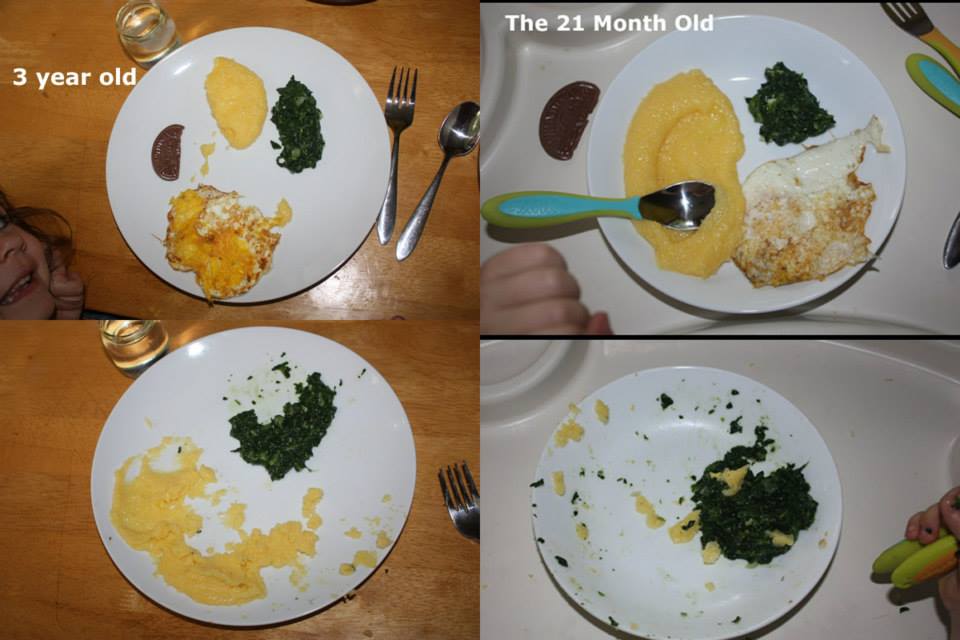
a Romanian meal Adina grew up with: cornmeal polenta, garlicky spinach and fried egg. Plus a little chocolate “orange” slice for a treat.
— 3 y.o. ate her chocolate first. Then she ate one egg and asked for a second and ate that too. The polenta you see was actually her second serving which I spread out thinly because it is very hot. She maybe had a bite of spinach.
— 21 mo old ate his chocolate first. Then he ate his egg and asked for about 4ths of the polenta and 3rds of the spinach. This kid LOVES his polenta, but although I’ve served this meal many times, this is the first time he gobbled up the spinach, let alone asked for more! He is now 2.5 and has only recently tried it again.
3 y.o.: tasted everything. Finished her first half patty, had a second ‘chicken’ patty half and ate at least half of it.
21 m.o.: tasted everything. Finished nothing but his juice.
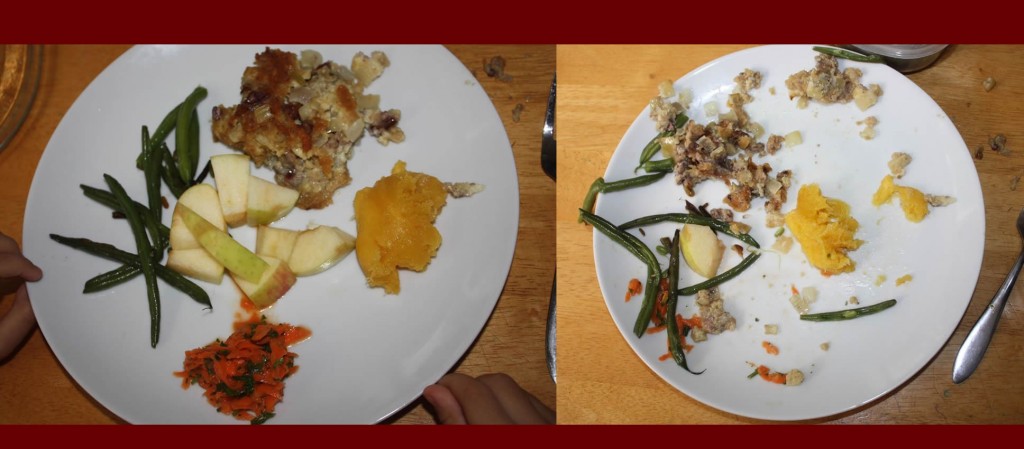
Green beans, cottage-cheese-based vegetarian “meatloaf,” acorn squash w/butter & honey, carrot salad, apple chunks. 3.5 y.o. had seconds only of the “meatloaf” and the “after” photo shows what was left.
Above was the 4 y.o.’s plate with leftovers served for lunch with the addition of asparagus. Notice how she piled on the asparagus but didn’t eat any but she did eat tofu (which she hadn’t touched the night before). A new day, a new appetite. Meanwhile 2 y.o. ate GIGANTIC portion of baked sweet potatoes & yams followed by some beans and rice. No tofu. No asparagus.
What the Kids Ate
In addition to the Before/After meal photos Adina does for her FB page, she also shared these meal records to show how her kids eat from time to time. Notice the wide variation in amounts eaten, both between the two of them and from meal to meal.
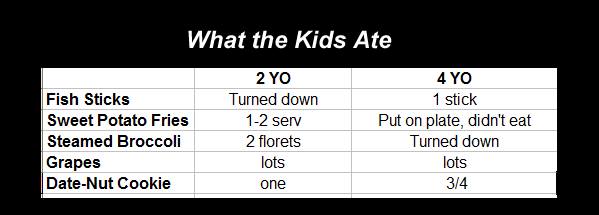
This was year ago, sometimes my 4 y.o. can eat 5-6 fish sticks in one sitting.
Worth noting is that typically Adina’s daughter loves salmon. The above are two occasions when she ate very little of it.
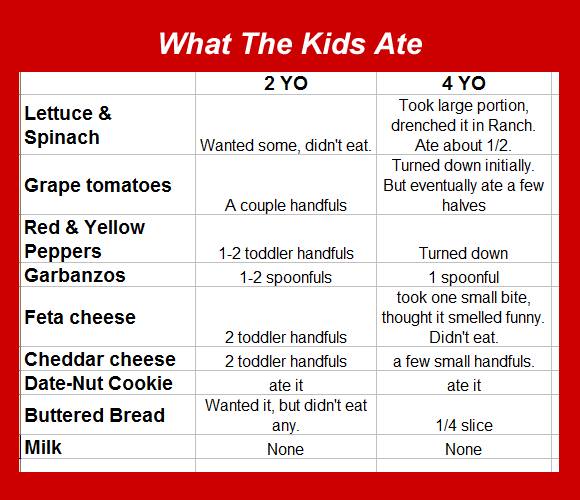
Looking at the selections this was most likely a “get rid of leftovers” lunch or dinner, hence the combo of foods.
This next food record comes from Adina’s blog and the topic is worth reading: Why it’s Okay to Relax About Your Child’s Eating http://healthylittleeaters.com/why-its-okay-to-relax-about-your-childs-eating/ — Note that in the record below the 4 y.o.’s intake is listed first.
What we hope you can tell from the food photos and food records above is that it’s normal for kids to pick at food and eat very little some meals. Even in families where kids are fed the same foods in the same way, there will be variation between each child. Some of your children may eat more than Adina’s kids or more variety. Others of you have children who eat less or a much narrower variety. Picky eating is normal in the toddler years. It is your response to this picky phase with a firm commitment to focusing on your feeding jobs that will yield the best long term results.
Coming Up Next: Your Child’s Growth & Dealing with Unsolicited Feeding Advice
Assignment: Use this worksheet to analyze your child’s food record for balance: BalancedNutritionChecklist
Discussion: What did this lesson get you thinking about? What do you want to focus on in terms of serving ‘balanced’ meals? What is your reaction to the food records and before/after photos Adina kept of her kids’ eating?
